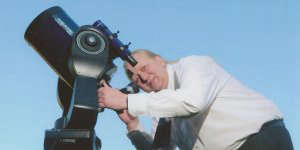
Monday 27th February to Sunday 5th March 2023
During February, Jupiter and Venus have appeared to be getting closer to each other in the early evening sky. On Wednesday 1st March they will be at their closest. If you venture outside just after dark, say around 7pm, the pair of planets will be setting towards the western horizon. Jupiter will be to the left of Venus.

I've mentioned a technical term called lunar libration before. It's where the Moon wobbles a bit as it orbits around us. On Saturday 4th March the Moon's southern polar region is tilted favourably towards us, making it a good opportunity to go looking for some of the lunar features on that part of its surface. Of course, the most obvious feature is the enormous crater "Tycho".

If you are outside around 7pm on 4th, the Moon will be located towards the south east. If at the same time you look towards the west, Jupiter and Venus will still appear to be quite close together as they set, but by now Jupiter will be a little below Venus.

For early risers, there are several excellent opportunities to spot the International Space Station during the coming week. Monday 27th February at 6.17am, Tuesday 28th at 5.31am, Thursday 2nd March at 5.31am and Saturday 4th at 5.32am. In all four cases, the ISS appears in the west and spends 5 - 6 minutes passing almost directly overhead before disappearing towards the east.
It will look like a bright star that is moving smoothly and silently across the sky. The Space Station is travelling incredibly fast at a speed of 8Km/s and completes an orbit of the Earth every ninety minutes. Some keen astronomers have even managed to track and photograph it with amateur equipment!

ISS image courtesy of Mark White / Sky At Night Magazine
Screenshots courtesy of Stellarium
Copyright Adrian Dening and Radio Ninesprings 2023
www.starsoversomerset.com

 Winter Coat Scheme
Winter Coat Scheme
 Recycling
Recycling
 Ilminster Local Plan
Ilminster Local Plan
 Hate Crime
Hate Crime
 False Fire Alarms
False Fire Alarms
 Dog DNA
Dog DNA









